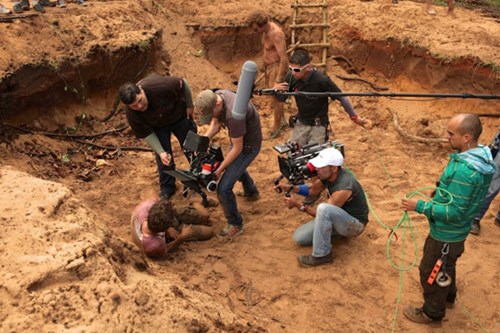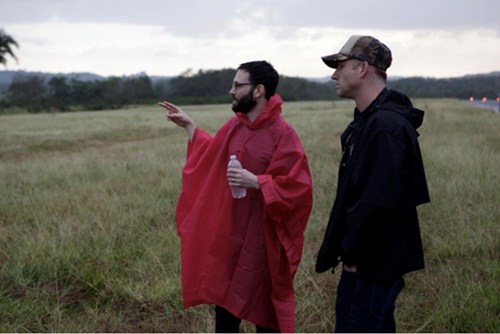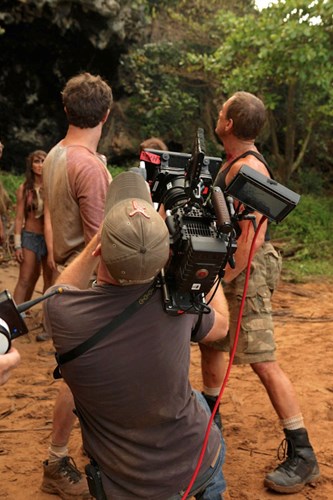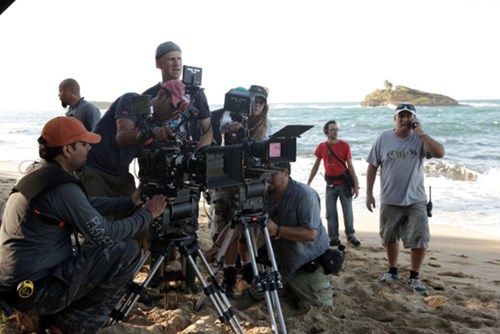ICG Magazine, January 3, 2014 by Pauline Rogers
A seasoned team of Puerto Rican Guild members clears the way for the indie feature Welcome to the Jungle.
Cinematographer Eric Haase admits that the original idea for Welcome to the Jungle, an action comedy that stars as Jean Claude Van Damme as Storm, an off-kilter ex-mercenary who leads an office teamwork leadership retreat, was to have L.A. double as an uninhabited tropical.
“That was less than ideal,” Haase smiles. So [director] Rob Meltzer and [producer] Justin Kanew did a little exploring and found the tax incentives in Puerto Rico would allow for this epic quality we wanted. Some of the humor is very absurd and we didn’t want the tone to get too broad. The movie goes to a dark place and I wanted the visual style to go right along with it and support this tone. Think Tropic Thunder.”
Welcome to the Jungle begins in a rather bleak office world dominated by bully Phil (Rob Heubel), which Haase decided to de-saturate – cool greens and cyans. “It’s not a happy place for Chris [Adam Brody],” Haase explains. “When the group gets to the jungle, however, he is able to take charge and we change to a much more rich and saturated look. Then, things start to devolve, as everything goes wrong and they get stuck on the island. Phil gains power and I introduce the cool tones again as he establishes his camp and tribe. By the end, the palette is again rather bleak and cool, until Chris and Phil fight in ‘the pit of destiny.’”
Haase says he wanted the audience to feel the scope of Puerto Rico’s island location. “When time permitted, I chose some close ups on wide to normal lenses so that we could see more background,” he describes. “For intimate moments, I went longer on the lenses. I tried to shoot a lot from lower angles in the jungle scenes, especially when things start to devolve. The situation takes on more weight and feels bigger as there is more at stake.”

Lead actor Adam Brody (on ground) with Eric Hasse (L), A-Camera/Steadicam Operator Edgar Colon (R)
The production team chose a friendlier looking beach and jungle canopy area for when the group first arrives to the island. “The uninhabited beach looks beautiful and the palm tree canopy where the group makes their camp is lush but also has a slight element of danger as it looks rough and unkempt,” Haase says. “When the group splits and Phil moves his camp to another part of the island, we chose to shoot in a jungle area that has a lot of huge rocks, vines, and an amazing cave. This type of jungle terrain was much rougher and gnarly looking. It felt rugged, and savage.”
Capture was achieved with two RED EPICs to maximize coverage on the group scenes and complete the picture on the 19-day schedule. “The Epic’s small form factor was a big part of the reason I chose the system,” Haase continues. “I also like to grade my own dailies and the RED ecosystem makes it easy. I had a MacPro with RedcineX, a RedRocket and a Tangent Wave panel on the truck and at lunch and after wrap and before call time I would hop on and dial in some looks very quickly.”
The DP says it’s always important for him to deliver the intended look. In the days before widespread digital capture, Haase would take digital stills of setups, Photoshop them and send them to the dailies colorist.” Now I can dial the look in myself if I want,” he observes, “if there is no budget for a real dailies colorist.”

Director Rob Meltzer (L) setting up a shot with DP Eric Haase (R)
Haase knew the HDRx feature would help in the jungle. “We had some scenes under the jungle canopy that looked out onto the ocean,” he explains. “The contrast ratio is extreme and I used the HDRx feature to capture a second exposure for the water. We were able to key this back in during the final grade [with some finessing]. I also knew that there would be times we would be running and gunning with the Epic shooting RAW. That provided flexibility to capture things quickly and massage them in post, although the DI budget was very tight. I think the image was more malleable and provided a little more overhead for error versus recording to a non-RAW format.”
The original plan was to shoot anamorphic, to best capture the scope of the locations and the many group scenes. But, budget restrictions nixed that approach, so Haase shot 2.35 common top line with a complete set of Cooke S4s. One set of primes – no zooms or doubles of any focal lengths – was used, in what Haase calls “a very minimal camera package compared to what I am used to on commercials, but also liberating in a way.”
Minimal filtration was employed – Tiffen IRNDs, a POLA, and some grads. “We were really pinching pennies on the camera order,” Haase reports. “PJ Gaffers also provided the lighting and grip gear – all sourced locally on the island. We had a basic HMI and tungsten package- one or two 18Ks and a 4K. I knew I would need to use some large HMI units in the jungle canopy by the beach where there are extreme contrast ratios and not a lot of opportunity to bounce direct light. The gear from PJ Gaffers was great and I was actually surprised at the amount available on the island.”

Haase shooting lead actors Adam Brody and Jean Claude Van Damme
Because of the short schedule Haase and Meltzer photo-boarded most of the movie. They found some local college interns who were interested in learning about the process, and acted as stand-ins for the photos. “It was really the only way we felt we could accomplish the amount and quality of work we wanted to shoot in 19 shoot days,” Haase admits. “I know we were not going to be given a lot of manpower or any rigging crew during the shoot, so I would have to be as specific ahead of time as possible.”
Weather always comes into play when shooting in a tropical location. “Half hour of rain at a time and then sunny skies and then some more rain,” Haase says, a little frustrated. “It delays production and creates a challenge to match lighting. It’s hard to sit by and watch it rain while the clock is ticking on the day and you have such a limited shooting schedule. If a scene is engaging, you can get away with a lot of sun/cloud inconsistency after you fix the contrast in the DI.”
The island’s terrain was also challenging. “Shooting in the jungle is difficult on everyone and things can take a little bit longer,” Haase adds. “But our Puerto Rican camera team [which included 1st AC César Marrero, A-camera/Steadicam Operator Edgar Colon, B-camera/2nd Unit DP Raphy Molinary, B-camera 1st AC Zoraida Luna, 2nd AC Alfredo Meléndez, Still Photographer Francisco Roman, and assistant/DIT Angel Castro] have figured out how to overcome the challenges and move fast.”
Sometimes comedies are anomalies: a light and fun tone is set against tense and challenging circumstances. “There’s a scene where Phil’s tribe of savages capture Chris and his friends and plan to execute them,” Haase explains. “It takes place outside the mouth of a large cave, and I wanted it to feel muted, cool, and contrasty. This is the end of Act Two and a low point when the movie is at it’s bleakest.
The DP says he took much more time shooting the execution scene than any other – over a day and a half. “Rob and I had photo-boarded it very specifically, so when it came time to shoot, we were able to move through most of it very quickly, except for the stunt where Chris jumps off the top of the cave, which took a bit more time,” he says.
The main challenge was maintaining a consistent light level over a day and a half. Fortunately the cave entrance was oriented so most of the action would be in shadow. A road nearby allowed Haase to line up three 20×20 solids as negative fill to create contrast. He also hung another 20×20 solid over the action by rigging it up to the trees, and positioned a few 18Ks as side and edge light coming in.
“It was a pretty big setup for the small crew we had and the grips in particular worked incredibly hard on this scene,” Haase recalls. “We had some black smoke in the background. The big rags had to move around a bit, especially the overhead, and we were constantly racing the clock. It was very intense but fun.”
Haase credits his camera, grip and electric crew for an amazing job on such a short schedule. “They were not only enthusiastic about the project but they were also very skilled at their craft,” he says. “They did some amazing things rigging large diffusion rags high in the trees and working with the natural terrain and features. In Puerto Rico, you get the sense that every crewmember is a filmmaker in his or her own right. They are invested in the project and really care about telling the story. They caught on to the fact that I speak some Spanish and so we had Spanish-only Fridays!”
The DP credits 1st AC César Marrero with excellent gear and prep management. “Rob and I had done so much planning I knew ahead of time which cameras needed to be where and in what mode, and I met with the camera department during prep and thoroughly reviewed the schedule,” Haase says. “When it came time to shoot, I found César was constantly working one step ahead and anticipating based on what we had discussed. Gaffer Leslie Colombani and Key Grip Gilo Rosario were also instrumental in helping us to move quickly and efficiently. Because of the tax incentives, we were able to achieve a good deal of production value for less money.”
The best part of the process for Haase was when he came back to the DI at Tunnel Post. “A good colorist can make or break the movie for a cinematographer and we pushed the producers to let us bring on someone we thought could deliver,” he remembers. “Luckily we ended up with a great colorist in Scott Gregory. We only had about 50 hours budgeted for the DI, which is almost half of what is typical.”

L to R: 1st AC Cesar Marrero, A-camera operator Edgar Colon, Eric Haase, B-camera 1st AC Zoraida Luna, 2nd AC Alfredo Melendez, 1st AC Franklin Vallette
Grading was done on the NuCoda Film Master, mostly from the 5K RED RAW files. The VFX were delivered as dpx and mostly done at 2K, while some shots were done at 3K depending on the 16×9 version compositions. Despite the abbreviated timeframe, grading went so smoothly the filmmakers were able to refine some key scenes.
“There is nothing better for a DP than grading in a DI theater every day with a talented colorist,” Haase concludes. “I distinctly remember the magical feeling viewing my first projected dailies on a big screen 15 years ago during my first 35mm feature and felt again that sense of excitement during this process.
“The moving image projected on a large screen is so powerful and I hope we always continue to have theatrical exhibition. I was thrilled to hear that this indie will get at least a limited theatrical release. We shot with the big screen in mind.”